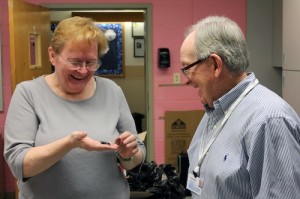By Larry Thornton
I retired in December 2008 after 47 years in the packaging and display industry. When retirement approached, I had no idea what it would mean for me. There was travel, golf, gardening and the luxury of reading many books. However, the transition from working daily to a life of leisure was not easy.
After moving to Peapack-Gladstone in December 2011, I familiarized myself with this picturesque rural town and, with the help of the town library, learned of the world-renowned medical and educational center located in the heart of town. Upon discovering Matheny, I set up an appointment with Gail Cunningham and David Curcio, who run Matheny’s volunteer services program. Gail and David graciously met with me for more than an hour and provided me with an extensive tour of the beautiful facilities that are perched on one of the highest elevations in Somerset County. As I left Matheny that Friday morning, my first thoughts reflected amazement. The citizens of New Jersey, and especially Peapack-Gladstone, should be proud to have such an incredible medical and educational facility for children and adults with medically complex developmental disabilities. Matheny has been a part of the fabric of our community since 1954.
I started volunteering at Matheny in March 2013. Sean P. Murphy, principal of The Matheny School, kindly gauged my interest in science and introduced me to Margaret Zappulla, one of Matheny’s teachers. I knew from the first day that a completely new challenge confronted me, as this environment was so different from what I did each day during the 47 years of my career. I was in a quandary as to how I would be able to contribute and help these young adults who could not communicate or verbalize. By the second day, my perception changed. I looked beneath the surface and saw a whole new and exciting world. I took time to reflect on how it would be for me not to be able to express myself or to walk. How does one deal with these conditions without feeling frustration? Therein lay the problem for most of these students and residents, who have so much to say and yet face ongoing obstacles to communication.
(First of two articles)

